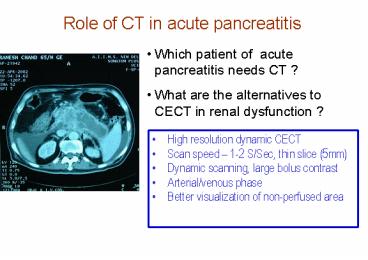Role of CT in acute pancreatitis - PowerPoint PPT Presentation
1 / 14
Title:
Role of CT in acute pancreatitis
Description:
Role of CT in acute pancreatitis. Which patient of acute ... Balthazar, Gastroenterology 1994; 106: 259 - 261. Why CECT ? Degree. Necrosis Extent ... – PowerPoint PPT presentation
Number of Views:94
Avg rating:3.0/5.0
Title: Role of CT in acute pancreatitis
1
Role of CT in acute pancreatitis
- Which patient of acute pancreatitis needs CT ?
- What are the alternatives to CECT in renal
dysfunction ?
- High resolution dynamic CECT
- Scan speed 1-2 S/Sec, thin slice (5mm)
- Dynamic scanning, large bolus contrast
- Arterial/venous phase
- Better visualization of non-perfused area
2
Why CECT ?
Degree Necrosis Extent Infection
Aspiration/culture
Peripancreatic fluid collection its
content Pseudocyst wall maturity,
contents Pseudoaneurysm Bowel
involvement
Balthazar, Gastroenterology 1994 106 259 - 261
3
Why identify pancreatic necrosis?
AIIMS (Jan 1997 Nov. 2000) N 205, (Death
20, 9.7)
Clinically severe pancreatitis (APACHE II gt8)
N72 (35) i CECT necrosis in 68/72
(94) i Death 18/72 (25)
Clinically mild/moderately severe
pancreatitis N123 (65) APACHE II lt 8 i CECT
necrosis 0/123 i Death 2/123 (1.5) (plt0.01)
18/20 (90) of those who died had ANP
4
Why identify pancreatic necrosis?
37/68 (54.4) ANP Infected 12/37 (32.4)
infected necrosis died 6/31 (20) sterile
necrosis died
5
Correlation of extent of necrosis with organ
failure and mortality
Plt0.001
Plt0.002
Extent of necrosis
6
Why identify pancreatic necrosis?
- Subject No. of Patients
- Edematous 992 71
- ANP 286 21
- Sterile 196/286 68
- Infected 90/286 32
- Panc. Abscess 36 3
- Pseudocyst 82 6
- Total 1396 100
Beger 1997 (May 1982 Dec 1995) World J Surg.
21 130 135
7
Why identify pancreatic necrosis?
- ANP 205
- Factor Patient Mortality p
- ANP
- 30 79 (39) 6 ( 8)
- 50 75 (37) 18 (24) lt 0.0001
- gt 50 51 (25) 26 (51)
- Extrapancreatic Necrosis
- Present 96 (47) 33 (34) lt0.02
- Absent 109 (53) 17 (16)
- Pancreatic Ascites
- Present 115 (56) 42 (37) Absent 90 (44) 8
(9) lt0.01 - Infected Necrosis
- Present 56 (41) 18 (32)
- Absent 82 (59) 8 (10) lt0.01
Beger, 1997
8
CT Balthazars Scoring
Score
A. Normal 0 B. Pancreatic
enlargement 1 C. Peripancreatic
inflammation 2 D. 1 peripancreatic fluid
collection 3 E. gt1 peripancreatic fluid
collection 4 No necrosis 0 1/3rd
necrosis 2 1/2 necrosis 4 gt1/2 necrosis 6
9
(No Transcript)
10
When should CECT be done?
- ANP gets established by 72 hours
- Within 48 hr 75 CT n88
- 96 hr - 88 CT No. CT. 255
- 7 d - 95 CT 3 CT/ Patient
- Atlanta 1992 40 pancreatologists all agreed
that the best time for is CT 3rd to 7th day
(Balthazar Radiology 1990 174 331 336)
11
Alternatives to CECT in renal insufficiency
- High risk for renal failure after contrast
- Diabetes mellitus upto 50
- Previous renal disease 30 90
- Drugsirenal perfusion (ACE inhibitors)
- Large volume contrast
- Use of furosemide/mannitol before using contrast
Precautions Hydration osmolality Assessment of
renal function / size Avoid nephrotoxic
drugs Use of nonionic contrast
Mechanism Release of free radicals, direct
toxicity on tubular epithelium, renal
hemodynamics
(Safirstein, NEJM 2000)
12
Alternatives to CECT in renal insufficiency
Calcium channel antagonists, dopamine, ANP,
Endothelin receptor antagonists useless
Acetylcystine 600 mg bd (n-83, S.Crgt1.2mg or GFR
lt 50 ml/m)
- Free radical scavenger
- S.nitrosothiol
- i
- Vasodilation
Tepel et al NEJM 2000 343 180 4
13
MRI Alternative to CECT in renal insufficiency
- Benefits
- Superior resolution
- No radiation
- Gadopentate dimeglumine (Gadolinium)
- Contrast CECT
- Volume required 10 ml
- T2 weighted images pick up gall stones
- Problems
- Sick patients with tubes
- Long time vs breath hold
- Availability
- Gas density vs Collection difficult to
differentiate
Needs evaluation in a prospective study
Chalmers, Eur. J Gastroenterol Hepatol 1997
14
Summary
- CT is necessary if diagnosis is in doubt.
- CECT is necessary to identify ANP between 3rd to
7th day of onset of AP - ANPs clinical counter part is clinical/biochemica
l severity of the disease objective assessment
should be done by APACHE II (gt8) or Ransons
criteria (gt3) - Other clinical pointers of ANP - no improvement
in 72 hr - organ failure - - fever, leucocytosis
- Initial improvement followed by deterioration
- In presence of RF Acetylcystine CECT or MRI
using Gadolinium may be done































